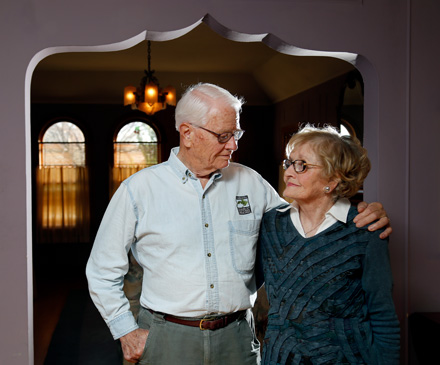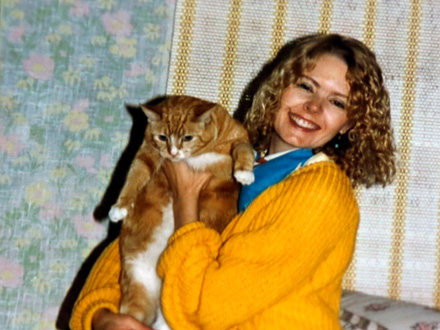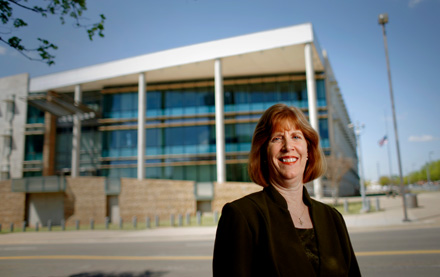Darla Slipke The Oklahoman
The walls in the front room of Susan Ferrell’s home are painted lavender, the same as they were when she fell in love with the house more than 20 years ago.
Decorative pottery from New Mexico, some filled with sand from her travels, and braided sweetgrass, which is revered as a sacred plant by some American Indian tribes, adorn the fireplace mantel.
Sitting near a book of Japanese fairytales in the study is a collection of prose by Alice Walker with a bookmark tucked between the pages, like Ferrell would come home tomorrow and keep reading.
Some details around the house have changed over the years – Ferrell’s tan Honda Accord decked with bumper stickers is gone from the garage and her family has given away many of her books and belongings. Still, other aspects of the home remain the way they were when Ferrell walked out the door for work on April 19, 1995.
For families like her parents, Don and Sally Ferrell of Chandler, the pain lingers 20 years after a bomb exploded in front of the Alfred P. Murrah Federal Building, resulting in the death of Susan Ferrell and 167 other people. A city and state that were devastated by the horrific event have worked to grieve and heal, but the bombing has left a permanent mark. The legacy of those who died will never be forgotten. Twenty years later, there are survivors and people who lost loved ones, co-workers and friends who remain in an emotional struggle that doesn’t answer to time.
It took a while before Sally Ferrell, Susan’s mother, could come to the house in Oklahoma City and not cry. It was a long time before she and her husband, Don, could bring themselves to spend the night there.
The little things kept the same in Susan’s home are a way of remembering her. The house is not a memorial that can’t be touched, but rather a lasting connection to their daughter. It has both a sentimental and a practical use as family and friends still gather there.
To them, it will always be “Susie’s house.”
“It’s not a shrine, but we think about her when we use it,” Don Ferrell said.
‘YOU DON’T GET OVER IT’
The days, weeks and even months leading up to the anniversary of the bombing each year are a time of reflection for all, but they can be haunting for survivors and those who lost loved ones or were directly affected by the bombing.
The emotional centers of the brain have no concept of time, said Dr. Harrison Smith, a clinical psychologist in Oklahoma City. Even though something happened 20 years ago, those parts of the brain can be triggered in the present as though very little time has gone by, Smith said.
“Twenty years is really nothing,” he said. “One of the things that you hear people who are grieving struggle with is that other people think they should be over it after years have gone by. This isn’t something that you really get over. You deal with it, but you don’t get over it. People who haven’t experienced traumatic loss don’t really understand that.”
The emotional centers of the brain can be triggered by anything that has a vague kind of familiarity to what happened, Smith said. For people who experienced the trauma, something like the backfire from a car, a certain smell or time of year, news about similar traumas, or even reaching an age where a loved one died, can trigger painful feelings and emotions.
People’s response to trauma can be positive or negative, Smith said. Post traumatic growth can occur if people can find ways to help others; a form of altruism born of suffering, Smith said.
Losses and trauma are harder to deal with when they are the result of another person’s decision or another person’s actions, Smith said. The realization that someone had a choice and did something with volition is harder for people to understand and cope with and can trigger more anger, he said.
Different people have different ways of grieving and coping.
Part of the cross on the roof of Saint Paul’s Episcopal Cathedral in downtown Oklahoma City was blown off in the blast. The cross remained standing, even though it was cracked and a portion of it broke off.
Many have said that the cross remaining was a symbol of hope in the midst of hopelessness, said the Very Rev. Justin Lindstrom, dean of the cathedral. A local artist cast the image of the broken cross into silver jewelry.
Some people found it helpful in their grieving process to wear jewelry of the broken cross and recognize that there was a lot of brokenness that occurred with the bombing, Lindstrom said. Other people didn’t want to wear the cross because it was too much of a painful reminder, he said.
“Some people will identify with the pain and identify with it in a way that they can then process it,” Lindstrom said. “Other people want to stay away from the pain if you will and process moving forward in a different way.”
‘YOU CAN’T FORGET’
Dianne Dooley was usually a prompt person. If she was supposed to be somewhere at 9 a.m., she would arrive 15 minutes early.
But she was running late on the morning of April 19, 1995.
Dooley was supposed to be in the Federal Employees Credit Union on the third floor of the Alfred P. Murrah Federal Building at 9 a.m., but a co-worker called around 8:55 a.m.
About five minutes later, Dooley looked up from the phone call at a clock in her office on the fifth floor of the federal building and realized she was late.
“I need to go,” she told her co-worker and ran down the stairs.
As she reached the third floor and started to push open the steel door, the bomb exploded – forcing the door back onto Dooley, knocking her to the ground.
If she hadn’t stopped to take that call, Dooley said she would not be alive today.
Had she been her usual punctual self, Dooley would not have seen her sisters get married, and she would not get to be an aunt to her 12 nieces and nephews.
Dooley would not have earned a master’s degree in rehabilitation counseling, and she wouldn’t have a 13-year-old daughter.
She and her husband, Jim, would not have been able to ride an elevator to the 49th floor of the Devon Tower last month to celebrate their 35th wedding anniversary.
They splurged on steak dinners with raspberry chocolate cake for dessert as they watched the sun set and a full moon rise over downtown Oklahoma City from their perch just a few blocks from the site of the Oklahoma City National Memorial & Museum.
“I appreciate every day because when you almost didn’t get those days, you have a greater appreciation for every day,” said Dooley, 54. “I try not to sweat the small stuff anymore, and I’m pretty good at it now. I try to tell people they’re important to me. I try to tell my daughter every day I love her.”
Dooley had a broken right toe and compound fractures to her right hand and wrist from the bombing. As she recovered, her father brought her news each day about the two women she was supposed to meet the morning of the bombing — Karan Shepherd and Linda McKinney.
With each passing day, their bodies still hadn’t been found.
Dooley feels a responsibility to live the best life she can in honor of her friends and others who died in the bombing.
“There’s no way to forget it,” Dooley said. “I think you kind of incorporate it into your journey or your story in life. You can’t forget.”
After the bombing, Dooley joined Saint Paul’s. Like her, the church was going through a rebuilding process after having been damaged in the explosion.
There, Dooley could cry in the pews and people understood. She could be angry in church and people understood.
“We were just kind of walking that walk together,” Dooley said. “They were rebuilding, and I was, in a sense, rebuilding and repairing myself.”
Dooley underwent six surgeries and 10 months of rehabilitation three days a week. She never regained full function in her right hand and still misses playing softball with her husband.
It took a while to work through the anger. Dooley, who works with veterans, had a hard time understanding why Timothy McVeigh, who was a veteran, would attack the country he served.
The anger she felt subsided with the birth of her daughter, Keely.
Dooley and her husband had just started talking about having a baby before the bombing. Those plans were delayed. Dooley had two miscarriages in the years following the bombing. When she was 40 years old, she became pregnant with Keely.
“That will heal your heart in a hurry,” Dooley said. “It went a long way for healing for me.”
She decided early on that the attack wasn’t going to keep her from her from her job, which she loved. It took about seven months before she was able to return to work part time and about a year before she was able to work full time. Today, Dooley works for the Department of Veterans Affairs as a supervisory vocational rehabilitation counselor. In that role, she counsels disabled veterans and also supervises other counselors. Dooley said her injuries from the bombing have helped her to be a better counselor for disabled veterans.
Sometimes she walks from her office on the first floor in the new federal building up to the third floor of the building to look at the memorial. Moving into that building — on the other side of Harvey and 6th streets — was hard for some, but Dooley takes comfort in being close to the memorial site. For her, it is a reminder of the days she almost lost and the gift she was given: The gift of time.
“It’s a reminder of how lucky I am still to be here,” Dooley said. “For me, it’s not a negative reminder. … It’s a positive reminder that we rebuilt. The city rebuilt.”
SUSIE’S HOUSE
Sitting in the front room of Susie’s house, Sally Ferrell thumbed through old photographs. She held out one of Susan in a bright floral dress smiling and holding her niece and nephew. The backdrop of the photo is a red barn on the farm where Susan grew up. It was taken on Easter of 1995 — three days before Susan, a 37-year-old Housing and Urban Development lawyer, died in the bombing.
“I can’t believe the time’s gone by,” Sally Ferrell said.
The hardwood floors in Susan’s home near Edgemere Park were perfect for the dancer, who performed with a troupe that specialized in what Susan called Middle Eastern dancing. She walked in with a realtor by her side and proclaimed: “I’ve been looking for this house all my life.”
“I said: ‘You don’t tell realtors that when you walk in the door,’ ” her mother recalled, laughing.
But it didn’t matter. The house was perfect. Susan had rented two other properties on the same street before buying her brick 1929 English Tudor home, with a wall of windows facing the street, original light fixtures and plenty of room for a garden.
She lived there just more than a year.
The morning of the bombing, Susan wore a brightly colored flower dress and told a co-worker how happy she was that spring had arrived. It meant she could plant her flowers. Susan’s home was always open to friends. When her family went to her house after the bombing, they found supplies for a party Susan was planning for a co-worker who was getting married.
They also found morning glory seedlings near the window.
Sally Ferrell decided to plant morning glories in her daughter’s memory. She gave away morning glory seeds with a note about Susan, asking others to plant the seeds in remembrance. That was, until she realized how the flowers travel.
“They will cover everything,” 81-year-old Sally Ferrell said of the flowers that climbed Susan’s backyard fence and into the neighbor’s trees. “We’re still trying to get them to stay home.”
The Ferrells have used their grief to help others. Don Ferrell went to New York City after September 11, 2001, to counsel grieving families. Sally Ferrell wrote letters to the families of the sailors who died in 2000 when the USS Cole was bombed in Yemen.
“You just know more about the pain,” she said.
One way of honoring Susan has been to keep her home like it was when she lived there — a place of community. Like Susan, the Ferrells have opened the house to friends. The house has remained a gathering place for family.
“She would love that family’s using it,” Sally Ferrell said.
“Every year we think we’d sell it, but we don’t.”
They kept Susan’s car in the garage until about two years ago, driving it occasionally. Bumper stickers on the vehicle that talked about carrying out random acts of kindness, celebrating diversity and braking for Route 66 historic sites, reflected a small piece of Susan.
“She was out to save the world,” her father said.
Susan’s family donated her car to the Salvation Army and gave away many of her books with a sticker inside connecting them to Susan’s library, but there are still reminders of Susan throughout the home, like a hole in the base of the laundry room door for her three rescue cats.
The Ferrells said they had wonderful support after the bombing, and they drew comfort from gestures of kindness from others.
“As bad as it was, it did bring the city together,” said Don Ferrell, 86.
“After it blew it apart, it brought it together.”
Don and Sally stopped by Susan’s house to prepare for guests this weekend. The house becomes a hub of activity each year around the anniversary of the bombing and the marathon, in which the Ferrell family takes an active part.
Three years ago, at the age of 83, Don Ferrell was the second-oldest male participant in the half marathon. This year, he will be passing out medals at the finish line. Sally Ferrell will be doing the same if she’s not waving a tambourine, a replica of the one Susan used when she danced.
The words “Love you Susie” are etched in faint white letters on a chalkboard that hangs in the kitchen. A picture a friend painted and gave to the Ferrell family of Susan dancing in a vibrant red and gold costume hangs in her dining room. Across the room, sits a photograph of Susan looking out at Alhambra, an ancient fortress in Spain, during a trip to Europe the summer before she died.
Sally Ferrell intends to paint the purple walls a lighter color sometime. She said they will let go of the house one day unless somebody in the family needs to live there.
“I think that would be neat if that worked out sometime, but you just don’t know what’s ahead,” she said. “It was pretty hard to come at first and it’s a different kind of feeling (now), but there’s always some bitterness to it, so I just call it a bittersweet experience.”
Over the years, there have been scholarships and other tributes in Susan’s honor. Susan helped start a symposium on rights of indigenous people at Saint Thomas University School of Law in Florida in 1994. The next symposium was named in her honor, and the symposium continued for 10 years dedicated to the high-energy attorney who fought for the underprivileged and was passionate about human rights. For the past 10 years, it became an intercultural human rights moot court competition named for Ferrell. This year, the competition attracted student teams from four continents.
Susan developed an appreciation for other cultures in her trips around the world.
She recorded her travels in journals, which her family has kept. An excerpt from one of her journals is etched across her tombstone: “I will celebrate life, the beauty and the pain.”
Both are reflected in Susan’s home. While her family still feels the pain of losing her 20 years ago, the beauty of her legacy remains. Don and Sally Ferrell care for the home, but they know it’s not theirs.
“We still call it Susie’s house,” Sally Ferrell said.




